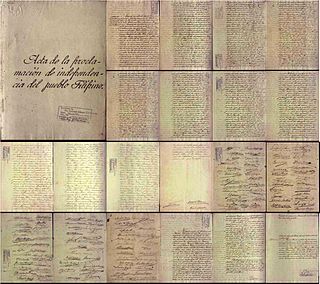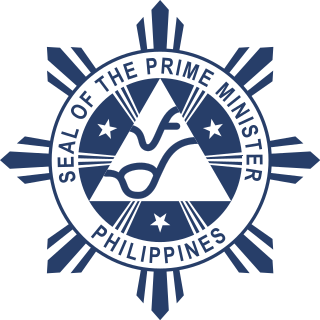 |
|---|
Listed here are the heads of state and government of the Philippines , from the Spanish occupation up to the current Republic.
 |
|---|
Listed here are the heads of state and government of the Philippines , from the Spanish occupation up to the current Republic.
The Royal Governor-General of the Philippines ruled the Spanish colony that is today the Republic of the Philippines except a two-year British occupation of Manila. This territory was also called the Captaincy-General of the Philippines and thus the governor also held the title of Captain General, a military rank conferred by the Spanish Cortes Generales. The men that held this position governed the Philippines and the rest of the Spanish East Indies from 1565 to 1821, on behalf of the Viceroyalty of New Spain.
The Spanish Monarchy was the head of state of the Philippines at this time, as it was also the monarch of New Spain.
During the period when the Philippine Revolution and Spanish–American War were proceeding concurrently, the U.S. established a military government from August 14, 1898, in the parts of the country under control of U.S. forces [1] On June 22, 1899, the Malolos Congress promulgated the Malolos Constitution, which established La República Filipina (in Spanish [2] ) or The Philippine Republic (in English [3] ). After the Spanish–American War was ended by the Treaty of Paris, in which Spain ceded the Philippine archipelago and other Spanish territories to the United States, the Philippine–American War ensued, ending in American victory on July 4, 1902.
From 1901 to 1935, the Philippines was governed by the United States of America. The Governor-General was appointed by the President of the United States and approved by the Senate. Unlike the Governors General of the British Dominions, the American Governors General exercised active executive authority over the nation they were appointed to administer, more like Governors of British colonies.
The Prime Minister of the Philippines (Spanish : Primer Ministro de Filipinas; Tagalog : Punong Ministro ng Pilipinas) was the official position of the head of the government (whereas the President of the Philippines was the head of state) of the Philippines. The position existed in the country from 1978 to 1986, as well as a limited version of such existed temporarily in 1899.
The President of the Philippines is the head of state and government of the Republic of the Philippines. The President of the Philippines in Filipino is referred to as Ang Pangulo or Pangulo ("Presidente," informally). The executive power is vested in the President of the Philippines.
Andrés Bonifacio was President (titled Supremo) of the Tagalog Republic's revolutionary government from 1896 to 1897. Emilio Aguinaldo was President of the insurgent Philippine Republic revolutionary government from 1899 to 1902. The Philippine government recognises Emilio Aguinaldo as "President of the First Republic". [4]
The incumbent president is Bongbong Marcos.

Emilio Aguinaldo y Famy was a Filipino revolutionary, statesman, and military leader who is the youngest president of the Philippines (1899–1901) and became the first president of the Philippines and of an Asian constitutional republic. He led the Philippine forces first against Spain in the Philippine Revolution (1896–1898), then in the Spanish–American War (1898), and finally against the United States during the Philippine–American War (1899–1901).
This article presents a timeline of Philippine political history focused on governmental transitions of the Philippine archipelago, major polities, invasion attempts, and insurgency movements from the pre-Hispanic period to the present. The information presented here is highly summarized, and more complete information can be found in more detailed articles linked below.

The president of the Philippines is the head of state, head of government and chief executive of the Philippines. The president leads the executive branch of the Philippine government and is the commander-in-chief of the Armed Forces of the Philippines.

The Philippine Revolution was a conflict waged by the Filipino revolutionaries against the Spanish colonial authorities in an attempt to win the archipelago's independence.

Miguel Malvar y Carpio was a Filipino general who served during the Philippine Revolution and, subsequently, during the Philippine–American War. He assumed command of the Philippine revolutionary forces during the latter, following the capture of resistance leader Emilio Aguinaldo by the Americans in 1901. According to some historians, he could have been listed as one of the presidents of the Philippines but, as of 2022, is not recognized as such by the Philippine government.

The Philippine Declaration of Independence was proclaimed by Filipino revolutionary forces general Emilio Aguinaldo on June 12, 1898, in Cavite el Viejo, Philippines. It asserted the sovereignty and independence of the Philippine islands from the 300 years of colonial rule from Spain.

The Malolos Congress, formally known as the National Assembly, was the legislative body of the Revolutionary Government of the Philippines. Members were chosen in the elections held from June 23 to September 10, 1898. The assembly consisted of elected delegates chosen by balloting in provincial assemblies and appointed delegates chosen by the president to represent regions under unstable military and civilian conditions. The Revolutionary Congress was opened on September 15, 1898 at Barasoain Church in Malolos, Bulacan. President Emilio Aguinaldo presided over the opening session of the assembly.

The prime minister of the Philippines was the official designation of the head of the government of the Philippines from 1978 until the People Power Revolution in 1986. During martial law and the fourth republic, the prime minister served as the head the Armed Forces of the Philippines. A limited version of this office, officially known as the President of the Council of Government, existed temporarily in 1899 during the First Philippine Republic.
The Philippine–American War, also known as the Philippine War of Independence or the Philippine Insurrection (1899–1902), was an armed conflict between Filipino revolutionaries and the government of the United States which arose from the struggle of the First Philippine Republic to gain independence following the Philippines being acquired by the United States from Spain. This article lists significant events from before, during, and after that war, with links to other articles containing more detail.

The Philippine Republic, now officially known as the First Philippine Republic and also referred to by historians as the Malolos Republic, was established in Malolos, Bulacan during the Philippine Revolution against the Spanish Empire (1896–1898) and the Spanish–American War between Spain and the United States (1898) through the promulgation of the Malolos Constitution on January 22, 1899, succeeding the Revolutionary Government of the Philippines. It was formally established with Emilio Aguinaldo as president. It maintained governance until April 1, 1901.

The history of the Philippines from 1898 to 1946 began with the outbreak of the Spanish–American War in April 1898, when the Philippines was still a colony of the Spanish East Indies, and concluded when the United States formally recognized the independence of the Republic of the Philippines on July 4, 1946.

The Political Constitution of 1899, informally known as the Malolos Constitution, was the constitution of the First Philippine Republic. It was written by Felipe Calderón y Roca and Felipe Buencamino as an alternative to a pair of proposals to the Malolos Congress by Apolinario Mabini and Pedro Paterno. After a lengthy debate in the latter part of 1898, it was promulgated on January 21, 1899.

The Hong Kong Junta was an organization formed as a revolutionary government in exile by Filipino revolutionaries after the signing of the Pact of Biak-na-Bato on December 15, 1897. It was headed by Emilio Aguinaldo and included high-level figures in the Philippine revolution against Spanish rule who accompanied Aguinaldo into exile in the Crown Colony of Hong Kong from the Philippines.

Pedro Nolasco Tongio Liongson was a member of the Malolos Congress which wrote the constitution of the First Philippine Republic in 1899 and served as First Director of Military Justice in the Republic's army during the Philippine–American War of 1899–1901. A trained lawyer and judge, Col. Liongson figured in and left his mark on a number of historic events in the Philippines.

The United States Military Government of the Philippine Islands was a military government in the Philippines established by the United States on August 14, 1898, a day after the capture of Manila, with General Wesley Merritt acting as military governor. During military rule (1898–1902), the U.S. military commander governed the Philippines under the authority of the U.S. president as Commander-in-Chief of the United States Armed Forces. After the appointment of a civil Governor-General, the procedure developed that as parts of the country were pacified and placed firmly under American control, responsibility for the area would be passed to the civilian.
A revolutionary government or provisional government has been declared a number of times in the Philippines, by various insurgent groups.

The Federal State of the Visayas was a revolutionary state in the Philippine archipelago during the revolutionary period. It was a proposed administrative unit of a Philippines under a federal form of government.

The Revolutionary Government of the Philippines was a revolutionary government established in the Spanish East Indies on June 23, 1898, during the Spanish–American War, by Emilio Aguinaldo, its initial and only president. The government succeeded a dictatorial government that had been established by Aguinaldo on June 18 and was dissolved and replaced by this government upon its establishment. This government endured until January 23, 1899, when the proclamation of the Malolos Constitution established an insurgent Philippine Republic government that replaced it.

The Dictatorial Government of the Philippines was an insurgent government in the Spanish East Indies inaugurated during the Spanish–American War by Emilio Aguinaldo in a public address on May 24, 1898, on his return to the Philippines from exile in Hong Kong, and formally established on June 18. The government was officially a dictatorship with Aguinaldo formally holding the title of "Dictator". The government was succeeded by a revolutionary government which was established by Aguinaldo on June 23.